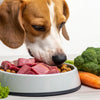How Much Kibble for a 50 lb Dog? A Comprehensive Guide for Pet Owners
- Houndsy
Table of Contents
- Introduction
- Understanding Your Dog's Nutritional Needs
- Calculating Daily Caloric Needs
- Reading Dog Food Labels and Feeding Charts
- Importance of Portion Control
- Body Condition Scoring
- Feeding Schedules
- Conclusion
Introduction
Did you know that nearly 60% of dogs in the United States are classified as overweight or obese? This alarming statistic underscores the importance of proper nutrition and feeding practices for our furry companions. As responsible pet owners, we want to ensure that our dogs maintain a healthy weight and receive the right amount of nourishment. If you have a 50 lb dog, you might find yourself asking: how much kibble should I be feeding them?
In this blog post, we'll explore the factors that determine how much food your dog should eat, practical feeding guidelines, and how to monitor your dog's health through their diet. By the end of this article, you'll have a clear understanding of the feeding requirements for your 50 lb dog and how to create a consistent routine that promotes their well-being. We’ll delve into essential topics such as nutritional needs, portion control, and the significance of high-quality ingredients, all while ensuring that your dog’s dining experience is as enjoyable as it is healthy.
Let's embark on this journey to ensure our furry friends are well-fed, healthy, and happy!
Understanding Your Dog's Nutritional Needs
When determining how much kibble for a 50 lb dog, it’s essential to recognize that dietary needs are not one-size-fits-all. Several factors play a pivotal role in shaping a dog's nutritional requirements:
Weight and Size
A dog's weight is the primary factor in calculating their food intake. For a healthy 50 lb dog, the amount of kibble will largely depend on their ideal weight, which may vary if they are overweight or underweight.
Age
Puppies, adult dogs, and senior dogs have different nutritional requirements. Puppies require more calories and nutrients to support their growth, while senior dogs may need fewer calories to maintain a healthy weight.
Activity Level
Dogs that are more active will require more calories than those who are less active. If your 50 lb dog is highly energetic, they may need to eat more to sustain their energy levels.
Health Conditions
Certain medical conditions, such as diabetes or obesity, may necessitate tailored feeding guidelines. Always consult with your veterinarian if your dog has specific dietary needs.
Food Quality
The caloric density of the dog food you choose plays a significant role. Some brands offer nutrient-dense formulas that require smaller portions, while others may need larger servings for the same caloric value.
Calculating Daily Caloric Needs
To determine how much dry food your 50 lb dog should consume, you first need to assess their daily caloric needs. As a general guideline, the Association for Pet Obesity Prevention suggests that adult dogs should consume approximately 20 to 30 calories per pound of body weight each day.
For a 50 lb dog, this translates to a daily intake of:
- Minimum Calories: 50 lbs x 20 calories = 1,000 calories
- Maximum Calories: 50 lbs x 30 calories = 1,500 calories
This range provides a solid baseline, but remember that individual needs may vary based on the factors mentioned earlier.
Example Calculation
Most commercial dog foods include feeding charts on their packaging, which provide recommendations based on weight and caloric content. For example, if the food you choose contains 400 calories per cup, you can calculate how many cups to feed based on your dog's caloric needs.
- Minimum Daily Intake: 1,000 calories ÷ 400 calories/cup = 2.5 cups
- Maximum Daily Intake: 1,500 calories ÷ 400 calories/cup = 3.75 cups
Thus, you should aim to feed your 50 lb dog between 2.5 to 3.75 cups of kibble daily, depending on their specific caloric needs.
Reading Dog Food Labels and Feeding Charts
To effectively use feeding charts, follow these steps:
- Identify Caloric Content: Check the label for the number of calories per cup of food. This information is crucial for calculating how much to feed your dog based on their caloric needs.
- Consult the Feeding Chart: Feeding charts will typically list recommended daily amounts based on weight intervals. For instance, if the chart suggests that a 50 lb dog should eat between 2.5 to 3 cups daily, you can cross-reference this with the caloric content to ensure it aligns with your dog's needs.
- Adjust as Needed: If your dog is overweight, you may need to feed them less than the recommended amount, while underweight dogs may require more. Always consult your veterinarian for tailored advice.
Importance of Portion Control
Portion control is vital for maintaining your dog’s health. Overfeeding can lead to obesity and associated health problems, including joint issues, heart disease, and reduced quality of life. Conversely, underfeeding can cause nutritional deficiencies that may lead to low energy levels, weakened immune function, and other health complications.
Health Risks of Overfeeding
The consequences of overfeeding are severe and can include:
- Joint disease
- Difficulty breathing
- Heart problems
- Reduced quality of life
- Shortened lifespan
Health Risks of Underfeeding
Underfeeding can lead to a range of issues, including:
- Nutritional deficiencies
- Poor immune function
- Low energy levels
- Weakened overall health
Body Condition Scoring
To assess your dog's ideal weight and portion sizes, consider using a body condition score (BCS) system. This method evaluates your dog's physical appearance and feel, helping you determine if they are underweight, at a healthy weight, or overweight.
How to Use Body Condition Scoring
- Feel the Ribs: You should be able to feel your dog’s ribs without excess fat covering.
- Check the Waist: When viewed from above, your dog should have a noticeable waist.
- Assess the Abdomen: The abdomen should be tucked up when viewed from the side.
Regularly assessing your dog's BCS allows you to adjust their food intake as needed, ensuring they remain at a healthy weight.
Feeding Schedules
Establishing a feeding schedule is crucial for maintaining your dog’s digestive health and preventing issues such as bilious vomiting syndrome. Here are some general guidelines for feeding frequency:
- Adult Dogs: Most adult dogs should be fed twice a day to maintain consistent energy levels.
- Puppies: Puppies require more frequent meals, usually three to four times daily, due to their higher energy needs.
- Senior Dogs: Senior dogs may benefit from more frequent smaller meals as their metabolism slows down.
Transitioning to a New Diet
If you decide to switch your dog’s food, it’s essential to do so gradually. A sudden change can cause gastrointestinal upset. Follow these steps for a smooth transition:
- Start Slowly: Mix a small amount of the new food with the current food.
- Gradually Increase: Over a week, slowly increase the proportion of the new food while decreasing the old food.
- Monitor Your Dog: Keep an eye on your dog’s stool and energy levels during the transition.
Conclusion
Feeding your 50 lb dog the right amount of dry food is a critical aspect of their overall health and well-being. By understanding their nutritional needs, utilizing feeding charts, and establishing a routine, you can significantly improve their quality of life. Remember to consult with your veterinarian for personalized advice tailored to your dog's unique circumstances.
As we strive to simplify and elevate the dog-feeding experience, consider the Houndsy Kibble Dispenser, designed to enhance your daily feeding ritual. This innovative product not only offers perfect portion control but also features mid-century modern design that complements your home decor beautifully. With a large storage capacity and an auto-locking mechanism, it simplifies mealtimes while keeping your furry friend safe and satisfied.
Explore the Houndsy Kibble Dispenser today and take your dog-feeding routine to the next level!
FAQ
- How much dry food should I feed my 50 lb dog? The general recommendation is between 1,000 to 1,500 calories per day, which translates to about 2.5 to 3.75 cups of food, depending on the caloric content of the specific dog food you choose.
- How can I determine my dog's ideal weight? Use a body condition score (BCS) system to evaluate your dog's physical appearance, checking for visible ribs, a defined waist, and a tucked abdomen.
- Should I feed my dog once or twice a day? Most adult dogs should be fed twice a day to maintain consistent energy levels. Puppies may require more frequent meals, while seniors might benefit from multiple smaller meals.
- What should I do if my dog is overweight? Consult your veterinarian for personalized advice, which may involve adjusting portion sizes, switching to a weight management formula, or increasing exercise.
- How do I adjust my dog's food intake if they are underweight? Gradually increase their food intake while monitoring their weight and condition. It’s always best to consult your veterinarian for tailored advice.
By following these guidelines and using the right tools, we can ensure our beloved dogs live healthy, happy lives with the right nutrition.












